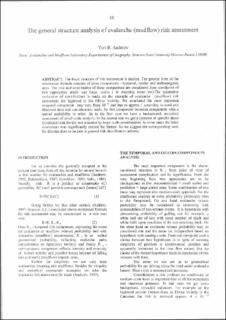| dc.contributor.author | Andreev, Yuri B. | |
| dc.contributor.editor | Hestnes, Erik | |
| dc.date.accessioned | 2023-08-02T18:38:25Z | |
| dc.date.available | 2023-08-02T18:38:25Z | |
| dc.date.issued | 1998 | |
| dc.identifier.isbn | 82-546-0184-4 | |
| dc.identifier.issn | 0078-1193 | |
| dc.identifier.uri | https://hdl.handle.net/11250/3082418 | |
| dc.description.abstract | The basic structure of risk assessment is studied. The general form of the assessment formula consists of three components - temporal, spatial and anthropogenic ones. The role and contribution of these components are considered from standpoint of two approaches small- and large- scales ( in mapping sense too).The quantative evaluation of contributions is made on the example of avalanche (rnudflow) risk assessment for highroad in the Elbrus vicinity. We concluded the most important temporal component may vary from 10 -6 and less to approx.l according to used and observed data' and consideration scale. So this component becomes comparable with a spatial probability in order. So in the first case we have a background, smoothed assessment of small-scale analysis. In the second one we get a concrete or specific dated (predicted) risk for the real situation by large-scale consideration. In some cases the latter assessment may significantly exceed the former. So we suggest the corresponding term for this risk kind to include in general risk classification scheme. | en_US |
| dc.language.iso | eng | en_US |
| dc.publisher | Norwegian Geotechnical Institute | en_US |
| dc.relation.ispartofseries | NGI Publication;203 | |
| dc.subject | Snow Avalanche | en_US |
| dc.subject | History | en_US |
| dc.subject | Avalanche-RnD | en_US |
| dc.subject | Snøskred-FoU | en_US |
| dc.title | The general structure analysis of avalanche (mudflow) risk assessment | en_US |
| dc.type | Chapter | en_US |
| dc.source.pagenumber | 58-59 | en_US |
